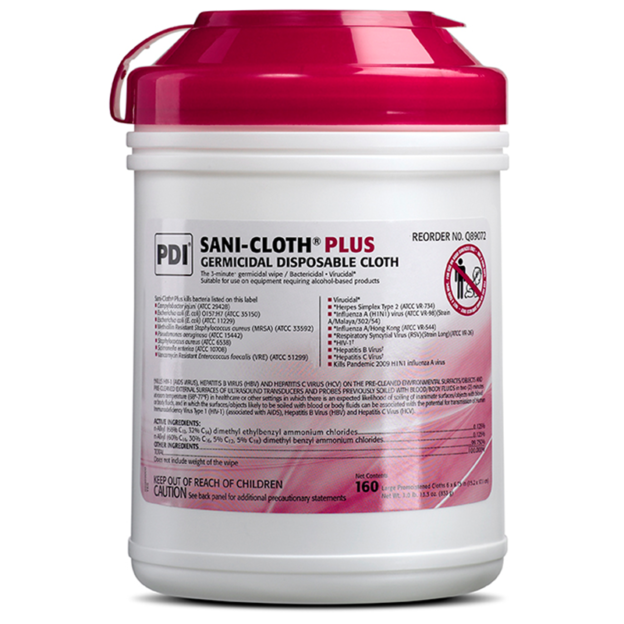Super Sani-Cloth® Germicidal Disposable Wipe
Fast contact time allows for a quick room turnover. Ideal for daily use in fast-paced environments that require…

We notice that you are visiting us from . This site only services Canadian-based visitors. Would you like to visit the site that is appropriate for your location?

Effective against 16 microorganisms in 3 minutes. Ideal for use in alternate care settings including physician and dental offices.
Sani-Cloth® Plus Germicidal Disposable Cloth are effective against SARS-CoV-2 (Coronavirus), the virus that causes COVID-19. Learn more
Can Sani-Cloth® Germicidal Disposable Wipes and Sani-Prime™ Germicidal Spray ship by air transportation?
Most Sani-Cloth brand products can be shipped via air transportation. However, Sani-Cloth Prime, Sani-Prime, Super Sani-Cloth wipes and Sani-Cloth Plus wipes cannot be shipped by air due to shipping regulations. These products are shipped via ground transportation only.
Can Sani-Cloth® Germicidal Disposable Wipes be used on toys?
Sani-Cloth wipes are available in EPA-Registered formulations that are approved and labeled for use on hard, non-porous toys. The products clean and disinfect in a one-step process, unless visibly soiled. Once disinfected, toys should be rinsed with potable water (tap water) to remove any residue and allowed to air dry. According to the Association for Professionals in Infection Control and Epidemiology (APIC), the recommended procedure for disinfecting toys is “Toys should be cleaned/disinfected between patients, especially those that are visibly soiled, mouthed, or used by patients in isolation. Toys should be washed thoroughly; disinfected with a non-toxic, low-level disinfectant and air dried completely.” Infection control experts recommend only washable toys for sharing. Stuffed animals and toys that cannot be cleaned and disinfected should not be shared.
SOURCE: APIC Text of Infection Control and Epidemiology, Chapter 39, p. 14-15, Association for Professionals in Infection Control and Epidemiology, 2011. www.apic.org
Do Sani-Cloth® Germicidal Disposable Wipes and Sani-Prime® Germicidal Spray contain any ingredient listed as carcinogenic?
Sani-Cloth Germicidal Disposable Wipes and Sani-Prime Germicidal Spray DO NOT contain any ingredients listed as a carcinogenic by the National Toxicology Program (NTP), American Conference of Governmental Industrial Hygienists (ACGIH), and Occupational Safety and Health Administration (OSHA). This applies to ALL Sani-Cloth products, including Sani-Cloth Prime, Sani-Prime, Super Sani-Cloth, Sani-Cloth AF3, Sani-Cloth Bleach, Sani-Cloth Plus, and Sani-Cloth HB brands. To register any disinfectant product with the US Environmental Protection Agency (EPA), the manufacturer is required to provide the EPA with the product’s manufacturing process, active and inactive ingredients, efficacy, chemistry, toxicity, and information about relevant impurities. The EPA conducts a thorough review of these materials and product’s ingredients. The agency would not register any product if it contained carcinogens without requiring relevant label warnings (40 CFR 156.10(g)(7)). As such, Sani-Cloth Wipes and Sani-Prime Spray do not contain carcinogenic label warnings.
Does NFPA 30 apply to Sani-Cloth® and Sani-Prime® products?
NFPA 30 applies to the storage of flammable and combustible liquids. PDI Sani-Cloth products, including Sani-Cloth Prime, Super Sani-Cloth, and Sani-Cloth Plus, and Easy Screen® Cleaning Wipe are exempt from the requirements of NFPA 30. This is because the scope of NFPA 30 (Section 1.1) states that it applies to the storage, handling and use of flammable and combustible liquids. Even though our products contain liquids that have been classified as flammable on the SDS, the wipes themselves are not classified as a liquid product. Rather, they are wipes impregnated with flammable liquids, even though there may be a small amount of free liquid in the bottom of the canister. According to the EPA, wipes are classified as a mixture product containing solids and liquids. The NFPA has also confirmed that wipes are not considered to be a liquid for the purposes of NFPA 30. In addition, NFPA Section 9.1.4(4) states that it does not apply to “medicines, foodstuffs, cosmetics and other consumer products that contain more than 50 per cent by volume of water-miscible liquids, with the remainder of the solution not being flammable where packaged in individual containers that do not exceed 5L (1.3 gallons) capacity.” For the above reasons, NFPA 30 does not apply to PDI products. Please verify these storage requirements against your insurance carrier requirements since they may be more stringent than NFPA 30.
What are the levels of disinfection for PDI EPA-Registered products?
All of PDI’s Sani-Cloth® brand products are EPA-Registered. Sani-Cloth Prime Germicidal Disposable Wipes (EPA reg number 9480-12), Sani-Prime™ Germicidal Spray (EPA reg number 9480-10), Sani-Cloth AF3 Germicidal Disposable Wipes (EPA reg number 9480-9), Super Sani-Cloth Germicidal Disposable Wipes (EPA reg number 9480-4) and Sani-Cloth Bleach Germicidal Disposable Wipes (EPA reg number 9480-8) have an efficacy claim against Mycobacterium bovis (i.e. Tuberculosis), qualifying these products as intermediate-level disinfectants. Each product exceeds the CDC’s recommendations for cleaning and disinfection in healthcare facilities. Sani-Cloth Plus wipes (EPA reg number 9480-6) and Sani-Cloth HB wipes (EPA reg number 61178-4-9480) do not have an efficacy claim against Mycobacterium bovis, which classifies these products as low-level disinfectants.
What is contact time and what happens if the surface dries before the stated contact time on a Sani-Cloth® and Sani-Prime®product label?
The contact time listed on the product label is the total amount of time that it takes to inactivate ALL of the microorganisms listed on the product label. This time is typically referred to in minutes, and should be communicated to staff members that are utilizing the disinfectant. In certain geographies and also in settings where temperature, relative humidity, and air changes may vary, it is possible that the surface may not remain visibly wet for the designated contact time. Current EPA guidance requires that the treated environmental surface or equipment remains wet for the contact time stated on product label. Additional wipes may be needed in order to comply with the EPA guidance, however the overall contact time does not change.
While the EPA requires the treated environmental surfaces to remain wet for the stated contact time, leading researchers in infection prevention offer an alternate view. In a commentary published in Infection Control and Hospital Epidemiology (March 2018, vol. 39, no. 3, pp 229-331), Dr. W.A. Rutala and Dr. D. J. Weber suggest that contact time and treatment time are mutually exclusive. They suggest that treatment time, irrelevant of wet time, should be followed by healthcare workers for wipes and sprays (except bleach products.) PDI will continue to monitor the science closely and provide their customers with the latest information as federal law permits.
What personal protective equipment (PPE) is required when using Sani-Cloth® Germicidal Disposable Wipes or Sani-Prime® Germicidal Spray?
For all Sani-Cloth and Sani-Prime products, according to the label instruction, the use of gloves or other PPE is not required to handle the product, particularly in non-clinical settings. Therefore, the routine use of PPE is not required unless potentially infectious blood or bodily fluids are present. If bloodborne pathogens are present, such as HIV, HBV, and HCV, follow label instructions. You should, however, wear PPE as appropriate in accordance with your facility protocol. Also, in compliance with good industrial and health hygiene, you should wear gloves when cleaning and disinfecting in a patient setting.
Where can I find the expiration date on Sani-Cloth® and Sani-Prime™ products?
For all Sani-Cloth Germicidal Disposable Wipes and Sani-Prime Germicidal Spray, the expiration date is stamped directly on the product. Sani-Cloth Prime, Sani-Prime, Sani-Cloth AF3, Super Sani-Cloth, Sani-Cloth Plus and Sani-Cloth HB products have a shelf life of 24 months from date of manufacture. Sani-Cloth Bleach wipes have a shelf life of 11 months from date of manufacture.
Please NOTE: Product can be used until the expiration date, even after being opened.
Some PDI products state "store at room temperature." What is the definition of room temperature?
For our EPA-regulated products, such as Sani-Cloth® and Sani-Prime™ brand products, room temperature is defined as an average temperature of 25◦ C (77◦ F) and within a temperature range of 15◦ C to 30◦ C (59◦ F to 86◦ F). For our FDA-regulated products, such as Prevantics® brand products, “controlled room temperature” indicates a temperature maintained thermostatically that encompasses the usual customary working environment of 20◦ C to 25◦ C (68◦ F to 77◦ F). SOURCE: USP 41-NF 36 General Notices and Requirements (August 1, 2013 First Supplements) Section 10.30.50. “Room Temperature” indicates the temperature prevailing in a working area. Section 10.30.60. Controlled Room Temperature
Which products are compatible with my equipment?
Our products are designed to be compatible. Extensive work has been performed on materials and equipment to confirm compatibility. For information on Compatible by Design™, our comprehensive program and resources for improving healthcare equipment compatibility, review our “PDI Material Compatibility Reference Guide” and other compatibility resources.
Please refer to the surface or equipment manufacturer’s guidelines for approved disinfecting instructions and contact your local PDI representative or Customer Care with any additional questions..
Are eye wash stations required for areas where Sani-Cloth® Germicidal Disposable Wipes and Sani-Prime® Germicidal Spray are utilized?
Eye wash stations are not required for areas where Sani-Cloth® Germicidal Disposable Wipes and Sani-Prime® Germicidal Spray are utilized as intended for surface disinfection. Although these products are classified as eye irritants, there is no OSHA or ANSI regulation that requires an eye wash station for eye irritants and therefore one not needed for these products. Handling of any chemical product, whether category 1, 2, 3, or 4, include using PPE when required, engineering controls if appropriate, and safe work practice controls to minimize any risk of exposure